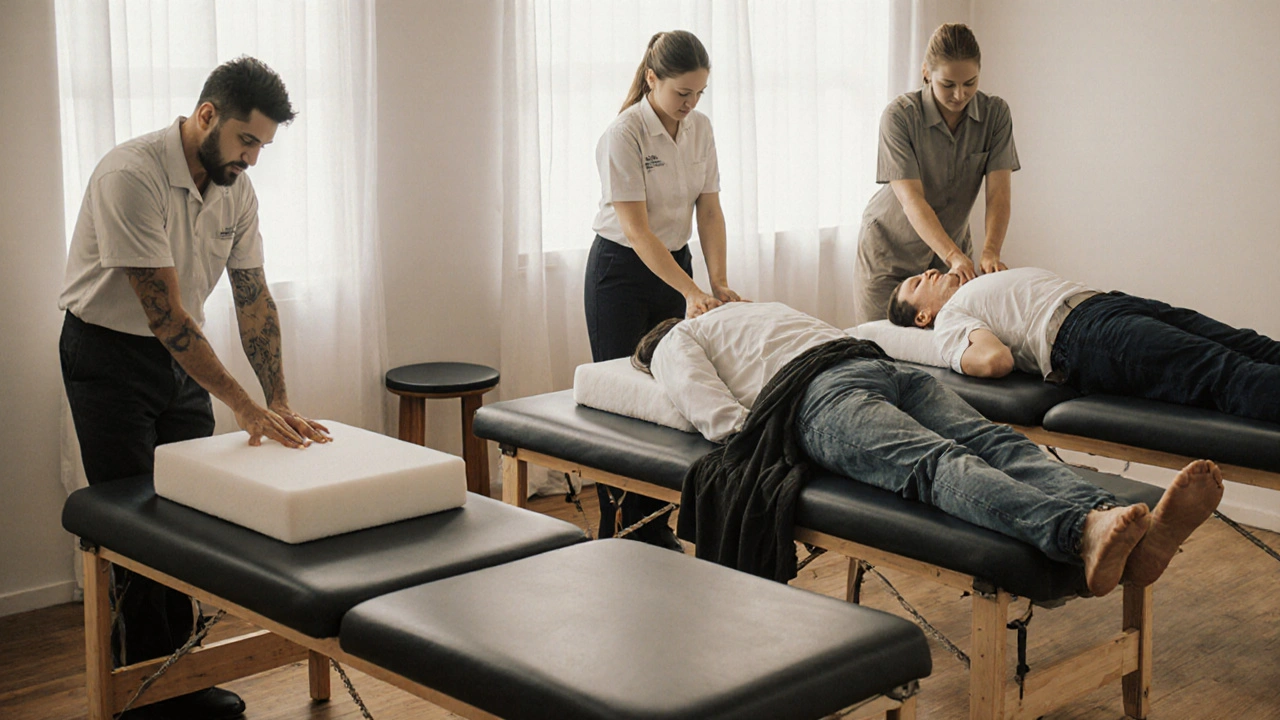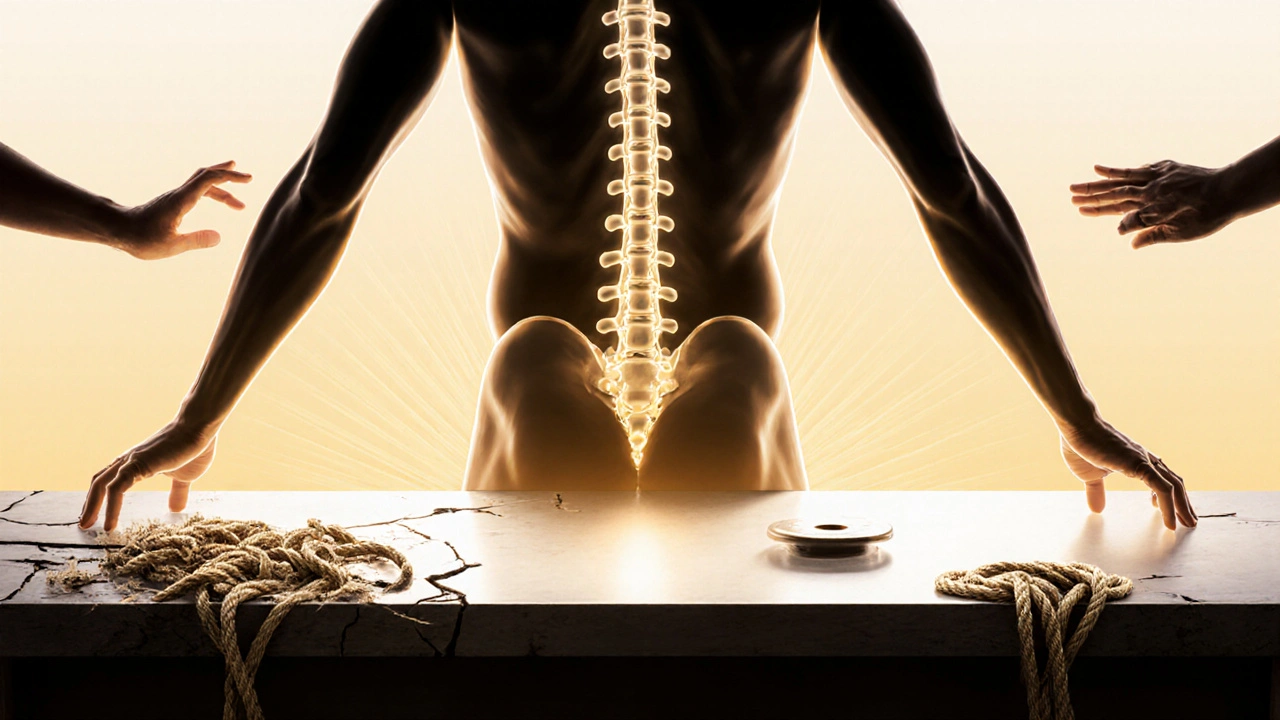Ước lượng tần suất massage bàn vắt sữa
Gợi ý tần suất massage
Bạn nên massage lần/tuần
Lý do:
Imagine lying on a smooth, padded surface, warm oil gliding over your skin, the gentle hum of a quiet room surrounding you. Now imagine that surface isn’t a luxury spa table-it’s a milking table. Yes, the same one farmers use to milk cows. And yes, people are using it to heal their bodies, release deep tension, and rediscover calm. Milking table massage isn’t a gimmick. It’s a practical, grounded form of bodywork that’s been quietly helping farmers, laborers, and even city dwellers find relief for over a decade.
Why a Milking Table?
You might wonder: why not just use a regular massage table? The answer is in the design. A milking table is low-usually about 24 to 30 inches high-and built to be stable, flat, and wide enough to support a full human body. Unlike high-end spa tables that tilt and adjust, milking tables stay put. That stability matters. When you’re lying on one, your spine doesn’t sink unevenly. Your shoulders don’t roll forward. Your hips stay aligned. This makes it ideal for deep tissue work, myofascial release, and long holds that target chronic tightness.
Many farmers and farm workers have used these tables for years-not for relaxation, but for recovery. After hours of bending, lifting, and standing on hard concrete, they’d lie on the milking table to let their muscles reset. The low height means you don’t need to climb up. You just step onto it, lie down, and let your body settle. No awkward positioning. No strain getting on or off.
Who Benefits Most?
Milking table massage isn’t just for people who work with animals. It’s for anyone whose body carries the weight of repetitive motion, heavy lifting, or long hours in one position.
- Farmers and ranchers who spend 10+ hours a day on their feet, bending over, pulling, pushing.
- Construction workers and landscapers with tight hips, stiff shoulders, and lower back pain.
- Office workers who sit all day and wake up with neck and upper back tension.
- Parents and caregivers who lift children, carry groceries, and never get a moment to stretch.
- Athletes recovering from endurance training-runners, cyclists, rowers-who need deep release without the luxury of a high-end table.
A 2023 study from the University of Wisconsin’s Agricultural Health Project tracked 142 farm workers who received weekly milking table massages over six months. Those who received the treatment reported a 47% reduction in chronic lower back pain and a 39% improvement in sleep quality. The table’s flat, firm surface allowed therapists to apply consistent pressure without the bounce or sink of foam padding, which is often too soft for deep tissue work.
How It Works
A milking table massage isn’t about aromatherapy or candles. It’s about mechanics. The therapist uses a combination of techniques:
- Deep tissue work with elbows and forearms to break up adhesions in the latissimus dorsi, glutes, and hamstrings.
- Myofascial release along the spine and ribcage, where tension builds from slouching or carrying heavy loads.
- Joint mobilization in the hips and shoulders, using the table’s stability to anchor the body while gently moving limbs.
- Trigger point therapy focused on the upper trapezius and thoracic paraspinals-areas that lock up from stress or poor posture.
Because the table is low and firm, the therapist can use their body weight more effectively. There’s no need to lean over awkwardly. They stand beside the table, use gravity, and apply pressure with control. This reduces strain on the therapist’s own body-and increases the effectiveness of the treatment.
Most sessions last 60 to 75 minutes. You wear loose clothing or underwear. No oils are used unless requested-many prefer dry techniques to avoid slipping. The room is quiet. The lights are dim. The only sound is your breath.

Where to Find It
You won’t find milking table massage in high-end spas. You’ll find it in rural wellness centers, agricultural extension offices, community health clinics, and a growing number of mobile massage services that specialize in manual labor recovery.
In Iowa, the Heartland Bodywork Collective runs monthly milking table massage nights at local co-ops. In Minnesota, the Farmer’s Recovery Program partners with physical therapists to offer subsidized sessions. Even in cities like Chicago and Portland, therapists trained in agricultural bodywork now offer mobile services using portable milking tables they’ve adapted for home use.
Prices vary. A session typically costs $50-$80-less than a standard massage at a spa, but often more effective for deep physical stress. Some community programs offer sliding scale rates or barter systems: a few hours of garden work in exchange for a session.
What to Expect in Your First Session
Your first time might feel strange. You’re not used to lying on something so plain. But within minutes, your body will relax. The table doesn’t hug you. It holds you. It doesn’t try to impress. It just works.
Here’s what happens:
- You’ll be asked to remove shoes and wear comfortable clothes.
- You’ll lie face down first. The therapist will start at your lower back, then work up to your shoulders.
- You’ll turn over. They’ll focus on your chest, arms, and legs.
- There’s no music. No talking unless you want to.
- You might feel sore the next day-that’s normal. It’s your muscles waking up.
After the session, you’ll feel lighter. Not just physically, but mentally. There’s something about lying on a table that’s been used for honest, hard work that makes you feel seen. You’re not being pampered. You’re being restored.

Can You Do It at Home?
Yes. Many people buy used milking tables from farm auctions for under $150. You can pad it with a thick foam mattress topper and use it as a home massage station. You don’t need fancy equipment. Just a foam roller, a tennis ball, and some time.
Try this simple routine after a long day:
- Lie face down on the table.
- Place a tennis ball under your right glute. Roll slowly for 2 minutes.
- Move the ball to your lower back, just above the hips. Hold on tight spots for 30 seconds.
- Turn over. Place the ball under your shoulder blade. Breathe into it.
- Stretch your arms overhead. Hold for 30 seconds.
Do this 3 times a week. In a month, you’ll notice your posture improves. Your sleep deepens. Your pain lessens.
The Bigger Picture
Milking table massage isn’t just a technique. It’s a philosophy. It says: healing doesn’t need luxury. It needs honesty. It needs stability. It needs to meet the body where it is-not where we wish it were.
In a world full of expensive gadgets, high-tech devices, and overpriced wellness retreats, this is a return to basics. A table built for work. Hands trained in care. A quiet space for rest.
If you’ve tried every kind of massage and still feel tight, heavy, or worn down-this might be what you’ve been missing. Not because it’s new. But because it’s real.
Is milking table massage only for farmers?
No. While it originated in agricultural communities, anyone with chronic muscle tension from physical work, long hours sitting, or repetitive movement can benefit. Office workers, parents, athletes, and manual laborers all report significant relief after sessions.
Does it hurt?
It can feel intense, especially if you’re very tight, but it shouldn’t be painful. Good therapists adjust pressure based on your feedback. You should feel a deep release, not sharp pain. If it hurts too much, speak up.
How often should I get a milking table massage?
For chronic pain or heavy physical work, once a week for 4-6 weeks is ideal. After that, maintenance every 2-4 weeks helps keep muscles flexible and pain low. For general wellness, once a month is enough.
Can I use a regular massage table instead?
You can, but you won’t get the same results. Regular tables are softer and higher, which makes it harder to apply deep, stable pressure. The milking table’s firmness and low height allow therapists to use their body weight more effectively, leading to deeper, longer-lasting release.
Is it safe if I have back problems?
Yes, as long as you tell your therapist about your condition. The milking table’s flat surface actually supports the spine better than many padded tables. Many physical therapists use it for rehab because it reduces strain on the neck and lower back during treatment.



